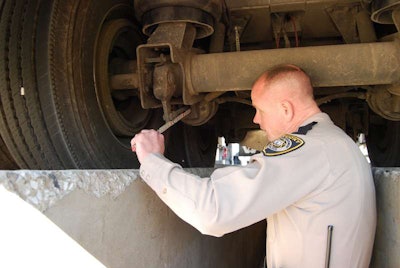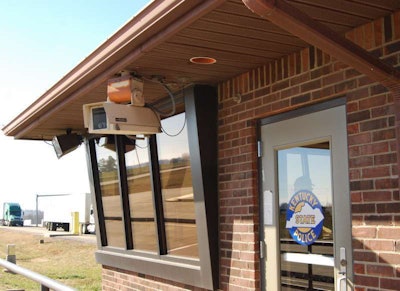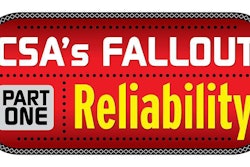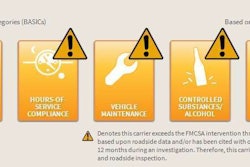

Industry-wide frustration with the Federal Motor Carrier Safety Administration’s Compliance, Safety, Accountability program was well apparent in the two days of meetings of an FMCSA advisory committee held this week.
Representatives of motor carriers, law enforcement, trade associations, brokers and other stakeholders voiced concerns at the Motor Carrier Safety Advisory Committee’s CSA Subcommittee meeting in Washington, D.C., Monday and Tuesday, over the enforcement prioritization system’s lack of crash fault/preventability and brokers/shippers’ view of scores as de facto safety ratings.
Most if not all frustration, however, pointed back to the central problem underlying each: The quality of the roadside data on which the entire system is based.
No easy answer to crash-fault question
Subcommittee head Dave Parker of Great West Casualty, former chairman of the MCSAC, began the meeting Feb. 5 with a request of fellow subcommittee members. Parker tasked each to provide him with a prioritized list of three specific CSA-related issues. Thinking ambitiously, Parker said, “I’d like to end [the meetings] with a document we’d be submitting to [the full MCSAC committee and then to the administrator], with comments on an issue this group feels requires the first priority.”
Though it’s sure to be on any number of committee members’ top three lists, crash fault/preventability may be unlikely to make the final cut for Feb. 6 deliberations. The issues inherent in determining fault and/or preventability are numerous, as accident reconstruction professionals made clear in morning presentations today.
While Gainesville, Ga.-based Jeffrey A. Kidd of Collision Specialities Inc. and Windsor, Ontario-based Jim Hrycay of Hrycay Consulting Engineers come from opposite backgrounds in the accident-reconstruction trade (Kidd’s a former patrol officer, Hrycay an engineer by training), both put a damper on the industry’s hopes of crash accountability and preventability being included in CSA scoring metrics.
When Con-way Freight Safety Vice Pesident Robert Petrancosta queried Kidd as to the safety of the assumption that “a centralized office could not correctly and accurately investigate all recordable crashes,” Kidd noted that “I’ve got to put my hands on the components to know what happened” in any accident.
General road-duty officers trained to look for “black and white” issues, or violations of law, in the aftermath of crashes often fail to collect necessary information to help determine preventability and fault, Kidd said. Of a total 239 crashes he investigated last year in his firm’s efforts primarily in defense of clients, he was able to find “contributing factors [not noted by the officer at the scene] in almost all of them…. There are many shades of grey in the many contributing factors.”
Hrycay stressed potential low-hanging fruit for improving the process by focusing commercial truck enforcement officer education around data collection at the scene of the accident. “They may get there sooner than [accident reconstructionists] like myself,” he said, “and we have to rely on the data they collect” in many cases to determine fault.
Problems Kidd has seen that are legion include roadside officers’ use of computational formulas based on skid length to determine how fast a truck was traveling that were meant for use with automobiles, thus not taking into account the reduced rate of deceleration of an 80,000-lb. vehicle. Also: Officers make the mistake of relying on testimony from a sole witness — often a single survivor, for instance, of two-vehicle crash — and fail to include any identifying information about the witness to help investigators. Further, urban and/or other traffic-dense jurisdictions’ preoccupation with clearing the roadway can make electronic-control-module-data downloads useless in the investigation, erasing last-stop data that ECMs manufactured by Detroit, Mercedes and Navistar record, particularly helpful in causation analysis.
“If you don’t have good data you can’t analyze anything,” Hrycay said. Long-term educational emphases “should be on making sure the front-line people are recording and collecting the right data. The level of data collected has been getting better, and more and more reliable — given the conditions front-line people are operating in, they’re doing a very decent job. But those with a higher level of expertise should continue to train and teach, but don’t give up the job of doing the work, because this is where you see new patterns and new technology changes.”
Data cart before the horse
FMCSA is working on enhancements to the public display of information at the CSA Safety Measurement System website. The agency plans to “put out a Federal Register notice soliciting information from the public” pertaining to the website in the “next couple of months,” said Bill Quade, FMCSA Associate Administrator for Enforcement. “Depending on what we get, in the Spring we’d propose specific changes to the way we display information” there.
While members of the MCSAC CSA subcommittee offered a variety of suggestions in the second half of the meeting, including a potential return to a more prominent role for disclaimers about appropriate use of SMS data by members of the public, discussion repeatedly ambled back to bedrock data-quality issues.
True Value Company Transportation Senior Director Gary Palmer noted that carriers are now dealing with the growing reality that “there are a lot of shippers out there using this data without a clue about any of the problems. People in our society today don’t read the legalese — I appreciate that there is a disclaimer, but I don’t think people are reading it…. Until we fix the data we’ve got to make that very clear. I’ve got shippers who are eliminating carriers from consideration whose relative score [is as low as] 40-50 percent” in one or more Behavioral Analysis and Safety Improvement Category.
When the public views a CSA BASIC percentile measure, said Petrancosta, “you should have a big pop-up note that there is a strong correlation or no correlation” to actual crash risk, the latter of which has been demonstrated for both Driver Fitness and Controlled Substances/Alcohol BASICs.
Jeff Tucker, head of the Tucker Company Worldwide brokerage, questioned the public usefulness of the scores in total. “I am struggling tremendously with what to do with the data right now” in his business, he said. It’s usefulness outside of the purposes of law enforcement and motor carriers, he suggested, was little.
Several panelists suggested not displaying the BASIC scores but continuing to include the data for a sort of carrier version of driver Pre-Employment Screening Program reports.
“I understand the data’s not perfect,” said FMCSA’s Quade, “but I don’t see a good alternative that we can implement in the political realities of the day.” Furthermore, he added, “hiding the data would take investigators off the road and into our [Freedom of Information Act] office to deal with the requests,” an ultimate detriment, he felt, to safety.










